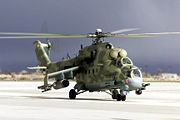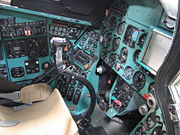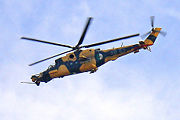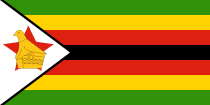Mil Mi-24
| Mi-24 / Mi-25 / Mi-35 | |
|---|---|
 |
|
| Mil Mi-24D | |
| Role | Attack helicopter |
| Manufacturer | Mil |
| First flight | 1969 |
| Introduced | 1972 |
| Status | Active |
| Primary users | Russian Air Force ca. 50 other users (see operators) |
| Number built | 2000 (estimated) |
| Developed from | Mil Mi-8 |
| Variants | Mil Mi-28 |
The Mil Mi-24 (Cyrillic Миль Ми-24, NATO reporting name "Hind") is a large helicopter gunship and low-capacity troop transport produced by Mil Moscow Helicopter Plant and operated from 1972 by the Soviet Air Force, its successors, and over thirty other nations. In October 2007, the Russian Air Force announced it would replace its 250 Mi-24 helicopter gunships with 300 more modern Mi-28s and possibly Ka-50s by 2015.[1][2]
In NATO circles the export versions, Mi-25 and Mi-35, are simply denoted with a letter suffix as "Hind D" and "Hind E" respectively. Soviet pilots called the aircraft летающий танк (letayushchiy tank, “flying tank”). More common unofficial nicknames were Крокодил (Krokodil, “Crocodile”), due to the helicopter's new camouflage scheme [3] and Стакан (Stakan, “Glass”), because of the flat glass plates which surrounded the three place cockpit of the Hind A version.
Development



During the early 1960s, it became apparent to Soviet designer Mikhail Leont'yevich Mil that the trend towards ever-increasing battlefield mobility would result in the creation of flying infantry fighting vehicles, which could be used to perform both fire support and infantry transport missions. The first expression of this concept was a mock-up unveiled in 1966 in the experimental shop of the Ministry of Aircraft's factory number 329 where Mil was head designer. The mock-up designated V-24 was based on another project, the V-22 utility helicopter, which itself never flew. The V-24 was similar in layout and configuration to the UH-1A Huey, with a central infantry compartment that could hold eight troops sitting back to back, and a set of small wings positioned to the top rear of the passenger cabin, capable of holding up to six missiles or rockets, with a twin-barreled GSh-23L cannon fixed to the landing skid.
Mil proposed the design to the heads of the Soviet armed forces, and while he had the support of a number of strategists in the armed forces, he was opposed by several more senior members of the armed forces who believed that conventional weapons were a better use of resources. Despite the opposition, Mil managed to persuade the defence minister's first deputy, Marshal Andrey A. Grechko, to convene an expert panel to look into the matter. While the panel's opinions were mixed, supporters of the project eventually held sway, and a request for design proposals for a battlefield support helicopter was issued.
Mil engineers prepared two basic designs: a 7-ton single-engine design and a 10.5-ton twin-engine design, both based on the 1,700 hp Izotov TV3-177A turboshaft. Later, three complete mock-ups were produced, along with five cockpit mock-ups to allow the pilot and weapon station operator positions to be fine-tuned.
The Kamov bureau suggested an army version of their Ka-25 Hormone ASW helicopter as a low-cost option. This was considered but later dropped in favor of the new Mil twin-engine design. A number of changes were made at the insistence of the military, including the replacement of the 23 mm cannon with a rapid-fire heavy machine gun mounted in a chin turret, and the use of the then-under development 9K114 Shturm (AT-6 Spiral) anti-tank missile.
A directive was issued on 6 May 1968 to proceed with development of the twin-engine design. Work proceeded under Mil until his death in 1970. Detailed design work began in August 1968 under the codename Yellow 24. A full scale mock-up of the design was reviewed and approved in February 1969. Flight tests with a prototype began on 15 September 1969 with a tethered hover, and four days later the first free flight was conducted. A second prototype was built, followed by a test batch of ten helicopters.
Acceptance testing for the design began in June 1970, continuing for 18 months. Changes made in the design addressed structural strength and fatigue problems, and reduced vibration levels. Also, a 12-degree anhedral was introduced to the wings to address the aircraft's tendency to Dutch roll at speeds in excess of 200 km/h, and the Falanga missile pylons were moved from the fuselage to the wingtips. This gave the helicopter its characteristic wings. The tail rotor was moved from the right to the left side of the tail, and the rotation direction reversed. The tail rotor now rotated up on the side towards the front of the aircraft, into the downwash of the rotor, which increased the efficiency of the tail rotor. A number of other design changes were made until the production version Mi-24A (izdeliye 245) entered production in 1970, obtaining its IOC in 1971. It was officially accepted into the state arsenal in 1972.[4]
Design



The core of the aircraft was derived from the Mil Mi-8 (NATO reporting name "Hip"), two top-mounted turboshaft engines driving a mid-mounted 17.3 m five-blade main rotor and a three-blade tail rotor. The engine configuration gave the aircraft its distinctive double air intake. Original versions have an angular greenhouse-style cockpit; Model D and later have a characteristic tandem cockpit with a "double bubble" canopy. Other airframe components came from the Mi-14 "Haze". Two mid-mounted stub wings provide weapon hardpoints, each offering three stations, in addition to providing lift. The load-out mix is mission dependent; Hinds can be tasked with close air support, anti-tank operations, or aerial combat. The body is heavily armored and the titanium rotor blades can resist impacts from .50 caliber (12.7 mm) rounds. The cockpit is overpressurized to protect the crew in NBC conditions.
Considerable attention was given to making the Mi-24 fast. The airframe was streamlined, and fitted with retractable tricycle undercarriage landing gear to reduce drag. The wings provide considerable lift at high speed, up to a quarter of total lift. The main rotor was tilted 2.5° to the right from the fuselage to counteract dissymmetry of lift at high speed and provide a more stable firing platform. The landing gear was also tilted to the left so the rotor would still be level when the aircraft was on the ground, making the rest of the airframe tilt to the left. The tail was also asymmetrical to give a side force at speed, thus unloading the tail rotor.[4]
As a combination gunship and troop transport, the Mi-24 has no direct NATO counterpart. While some have compared the UH-1 ("Huey") as NATO's direct counterpart to the Mi-24, this is inaccurate. While UH-1s were used in Vietnam to ferry troops, and were used as gunships, they were not able to do both at the same time. Converting a UH-1 into a gunship meant stripping the entire passenger area to accommodate extra fuel and ammunition, making it useless for troop transport. The Mi-24 was designed to do both, and this was greatly exploited by airborne units of the Soviet Army during the 1980-1989 Soviet invasion of Afghanistan. The closest Western equivalent was the Sikorsky S-67 Blackhawk, which utilized many of the same design principles and was also built as a high-speed, high-agility attack helicopter with limited troop transport capability; it, like the Mi-24, was also designed using many components from an already existing product, the Sikorsky S-61, itself a close approximation to the Mi-8/Mi-14. The S-67, however, was never adopted for service.
Operational history
Ogaden War (1977-1978)
The first use of the Mi-24 in combat was with the Ethiopian forces during the Ogaden War against the Somalis. The helicopters formed part of a massive airlift of military equipment from the Soviet Union, after the Soviets switched sides towards the end of 1977. The helicopters were instrumental in the combined air and ground assault that expelled Somali forces from Ethiopia by the beginning of 1978.[5]
Cambodian-Vietnamese War (1978)
The Mi-24A was extensively used by the Vietnam People's Air Force in the Cambodian-Vietnamese War. The gunships destroyed many Khmer Rouge bases and outposts up until 1986, when KR forces were driven to the border of Thailand.
Chadian-Libyan conflict (1978-1987)
The Libyan air force actively used Mi-24As and Mi-25s during their numerous interventions in Chad's civil war.[4] The Hinds were first used in October 1980 in the battle of N'Djamena where they helped the People's Armed Forces seize the capital.
In March 1987 the Armed Forces of the North, which were backed by the USA and France, managed to seize a Libyan air force base at Ouadi-Doum in Northern Chad. Among the aircraft captured during this raid were three Mi-25s. These were turned over to France, which in turn sent one to the United Kingdom and one to the USA.[4]
See also Toyota War and Operation Mount Hope III.
Soviet war in Afghanistan (1979-1989)
The aircraft was operated extensively during the Soviet invasion of Afghanistan, mainly for bombing Mujahideen fighters. The US supplied heat-seeking Stinger missiles to the Mujahideen, and the Soviet Mi-8 and Mi-24 helicopters proved to be favorite targets of the rebels.
First deployment
Hinds were supplied to the Afghan government in April 1979 to deal with Mujahideen guerrillas.[6] The Afghan pilots were well-trained and made effective use of their machines, but the Mujahideen were not soft targets. The first Hind to be lost in action was shot down by guerrillas on 30 May 1979.
The situation in Afghanistan grew worse and on 25 December 1979 Soviet troops were committed to the war, an action that would prove a major blunder. The Red Army found itself involved in a guerrilla war in a country where the rugged terrain favored the locals, who were enthusiastic, competent, and thoroughly determined fighters. The Hind seemed like an excellent weapon to help deal with the Mujahideen. Soviet field commanders requested all the Hinds they could get.
Early combat experience
After a brutal learning curve in the face of Afghan rebels, Hind pilots learned to be dangerous and cruel themselves, and the rebels called the Hind "Shaitan-Arba" (Satan's Chariot)".[6] In one case, a Hind pilot who was out of ammunition managed to rescue a company of infantry by maneuvering aggressively towards Mujahideen guerrillas and scaring them off. The Hind was popular with ground troops, since it could stay on the battlefield and provide fire as needed, while "fast mover" strike jets could only stay for a short time before heading back to base to refuel.
The Hind's favoured munition was the 80mm (3.15 in) S-8 rocket, the 57mm (2.24 in) S-5 having proven too light to be effective. The 23 mm (0.98 in) gun pod was also popular. Extra rounds of rocket ammunition were often carried internally so that the crew could land and self-reload in the field. The Hind could carry ten 100-kilogram (220-pound) iron bombs for attacks on strongpoints, while harder targets could be dealt with a load of four 250-kilogram (550-pound) or two 500-kilogram (1,100-pound) iron bombs. Some Hind crews became expert "snipers" dropping or tossing bombs precisely on targets. Fuel-air explosive bombs were also used in a few instances, though crews initially underestimated the sheer blast force of such weapons and were caught by shock waves that rattled their teeth.
Combat experience quickly demonstrated the disadvantages of having Hinds carrying troops. Gunship crews found the soldiers a concern and a distraction while being shot at, and preferred to fly lightly loaded anyway, especially given their operations from high ground altitudes in Afghanistan. Hind troop compartment armour was often removed to reduce weight. Troops would be carried in Mi-8 helicopters while the Hinds provided fire support.
It did prove useful to carry a technician in the Hind's crew compartment, handling a light machine gun in a window port. This gave the Hind some ability to "watch its back" while leaving a target area. In some cases a light machine gun was fitted on both sides to allow the technician to move from one side to the other without having to take the machine gun with him. Trying to shift a machine gun from one side of a helicopter to another while it maneuvered under fire was not merely awkward and inconvenient, it was an invitation to deadly accidents.
This weapon configuration still left the gunship blind to the direct rear, and Mil experimented with fitting a machine gun in the back of the fuselage, accessible to the gunner through a narrow crawlway. The experiment was highly unsuccessful, as the space was cramped, full of engine exhaust fumes, and otherwise unbearable. During a demonstration, an overweight Soviet Air Force general got stuck in the crawlway.[4] Operational Hinds were retrofitted with rear-view mirrors to help the pilot spot threats and take evasive action.
The Hinds not only protected helicopter troop assaults and supported ground actions; they also protected convoys, using rockets with flechette warheads to drive off Mujahideen ambushes, performed strikes on predesignated targets, and engaged in "hunter-killer" sweeps. The hunter-killer Hinds operated in pairs at minimum, more often groups of four or eight, to provide mutual fire support. The Mujahideen learned to move mostly at night to avoid the gunships, and in response the Soviets trained their Hind crews in night-fighting, dropping parachute flares to illuminate potential targets for attack. The Mujahideen quickly caught on and scattered as quickly as possible when Soviet target designation flares were lit nearby.
High attrition rates
Gunship attrition rates were high.[6] The environment itself, dusty and often hot, was rough on the machines; dusty conditions led to the development of the PZU air intake filters. And of course, the rebels fought back whenever they could. Their primary air-defense weapons early in the war were heavy machine guns and anti-aircraft cannons, though they found anything smaller than a 23 millimeter gun generally did not do much more than annoy a Hind. The cockpit was heavily armoured and could withstand even .50 in (12.7mm) rounds, but the tail was unarmoured and extremely vulnerable to even small arms fire.
The CIA then began supplying the Afghan rebels with Stinger shoulder-launched, heat-seeking SAMs,[7] and the situation got considerably worse for Hind crews. The heat-seeking missiles sought out the Mi-24's exhaust, which came directly from under the main rotor, causing the aircraft to disintegrate when hit. This was later remedied by countermeasure flares and a missile warning systems installed in all Soviet Mi-4, Mi-8, and Mi-24 helicopters, giving pilots a chance to evade the missile or crash-land. Heat dissipaters were also fitted to exhausts to decrease the Hind's heat signature. These alleviated the Stinger threat but did not eliminate it.
Hinds were also used to shield jet transports flying in and out of Kabul from Stingers. The gunships carried flares to blind the missiles, and if worse came to worst, were under orders to try to take the hit from the missile themselves. The crews called themselves "Mandatory Matrosovs", after a hero of the Second World War who threw himself across a German machine gun to let his comrades break through.
Hind crews
Hind crews led a rough life in general. They carried AKS-74Us and other hand-held weapons to give them a better chance of survival if forced down.[6]
In such a kill-or-be-killed environment, Hind crews acquired a certain edge. Early in the war, head of Mil Marat Timoschenko visited Afghanistan to see what the troops thought of his helicopters, and gunship crews put on spectacular displays for him. They even demonstrated maneuvers, such as barrel rolls, which design engineers considered impossible. An astounded Dr. Timoschenko commented, "I thought I knew what my helicopters could do, now I'm not so sure!"[6]
End of Soviet involvement in Afghanistan
A Mi-24 was shot down during the night of 2 February 1989, with both crewmen killed. It was the last Soviet Hind lost during nearly ten years of warfare.
Hinds in Afghanistan after Soviet withdrawal

Hinds passed on to pro-Soviet Afghan forces during the war remained in dwindling service in the grinding civil war that followed the Soviet withdrawal.[6] Some were flown by defectors to Pakistan, and a few of these machines apparently found their way into the hands of the US Army.
Afghan Hinds in the hands of the ascendant Taliban gradually became inoperable, but a few flown by the Northern Alliance, which had Russian assistance and access to spares, remained operational up to the US intervention in Afghanistan in the fall of 2001. In 2008, the Afghan National Air Corps took delivery of six refurbished Mi-35 Hind helicopters, purchased from the Czech Republic with US money. The Afghan pilots were trained by India and were due to begin live firing exercises in May 2008 in order to escort Mi-17 transport helicopters on operations in restive parts of the country.
Iran–Iraq War (1980-1988)

The Mi-25 saw considerable use by the Iraqi Army during the long war against neighboring Iran.[8] Its heavy armament was a key factor in causing severe damage to Iranian ground forces. However, the Hinds lacked an effective anti-tank capability, as they were only armed with obsolete 9M17 Skorpion missiles. This led the Iraqis to develop new gunship tactics, with help from East German advisors. The Mi-25s would form "hunter-killer" teams with French-built Aérospatiale Gazelles, with the Hinds leading the attack and using their massive firepower to suppress Iranian air defenses, and the Gazelles using their HOT missiles to engage armoured fighting vehicles. These tactics proved effective in halting Iranian offensives, such as Operation Ramadan in July 1982.[9]
This war also saw the only confirmed air-to-air helicopter battles in history with the Iraqi Mi-25s flying against Iranian AH-1J SeaCobras (supplied by the United States before the revolution) on several separate occasions. Not long after Iraq's initial invasion of Iran on 22 September 1980, two Iranian SeaCobras crept up on two Hinds and hit them with TOW wire-guided antitank missiles. [10] One Mi-25 went down immediately, the other was badly damaged and crashed before reaching base. The Iranians pulled off a repeat performance on 24 April 1981, destroying two Mi-25s without incurring losses to themselves.
The Iraqis hit back, claiming the destruction of a SeaCobra on 14 September 1983; three SeaCobras on 5 February 1984; and three more on 25 February 1984. After a lull in helicopter losses, each side lost a gunship on 13 February 1986. A few days later, on 16 February, a Mi-25 shot down a SeaCobra, and a SeaCobra claimed a Hind on 18 February. The last engagement between the two types was on 22 May 1986, when Hinds shot down a SeaCobra.
The final claim tally was 10 SeaCobras destroyed and 6 Mi-25s destroyed. The relatively small numbers and the inevitable disputes over actual kill numbers makes it unclear if one gunship had a real technical superiority over the other. It appears that the outcome of the fights was dependent more on the tactical situation and pilot skill than the inherent merits of each machine. Iraqi Hinds also claimed a total of 43 kills against other Iranian helicopters, such as Agusta-Bell Hueys.[10]
In general the Iraqi pilots liked the Mi-25, in particular for its high speed, long range, high versatility and large weapon load, but disliked the relatively ineffectual weapons and lack of agility.[11]
Nicaraguan civil war (1980-1988)
Mi-25s were also used by the Nicaraguan Army during the civil war of the 1980s.[12][13] Nicaragua received 12 Hinds (some sources claim 18) in the mid-1980s to deal with American-backed "Contra" insurgents. [10] The Mi-25s performed ground attacks on the Contras and were also fast enough to intercept light aircraft being used by the insurgents. The US Reagan Administration regarded introduction of the Mi-25s as a major escalation of tensions in Central America.
Two Mi-25s were shot down by Stingers fired by the Contras. A third Hind was damaged while pursuing Contras near the Honduran border, when it was pounced on by Honduran F-86 Sabres and A-37 Dragonflies. A fourth was flown by a defecting Sandinista pilot to Honduras in December 1988.
Sri Lankan Civil War (1987-present)
The Indian Peace Keeping Force (1987-1990) in Sri Lanka used Mi-24s when an Indian Air Force detachment was deployed there in support of the Indian and Sri Lankan armed forces in their fight against various Tamil militant groups such as the LTTE. It is believed that Indian losses were considerably reduced by the heavy fire support provided by their Mi-24 gunships. The Indians lost no Mi-24s in the operation, as the Tigers had no weapons capable of dealing with the Crocodile at the time[14][10], although several sustained heavy damage from machine gun fire.
Since 14 November 1995, the Mi-24 has been used by the Sri Lanka Air Force in the continuing war against the LTTE and has proved highly effective providing close air support for ground forces. The Sri Lanka Air Force currently operates a mix of Mi-24/-35P and Mi-24V/-35 versions. They have recently been upgraded with modern Israeli FLIR and electronic warfare systems. Five were upgraded to intercept aircraft by adding radar, fully functional helmet mounted target tracking systems, and AAMs. At least five Hinds have been lost to LTTE MANPADs, and another two lost in attacks on airbases, with one heavily damaged but later returned to service.[14]
Gulf War (1991)

The Mi-24 was also heavily employed by Iraqis during their invasion of Kuwait, although most were withdrawn by Saddam Hussein when it became apparent they would be needed to help retain his grip on power in the aftermath of the war.
A few Hinds were later sent over the border into Iran, along with many other Iraqi military aircraft, in the hope of sparing them from destruction by allied air strikes. As with the previous Iraqi aircraft however, the Iranians kept them and used them in their own service.
Croatian War of Independence (1990s)
First unveiled in Croatia in 1993, twelve Mi-24s were effectively used in 1995 by the Croatian army in Operation Storm against Serbian contingents of the JNA, the former Yugoslavian army, and against Krajina army paramilitaries. This was in spite UN weapons and arms embargo.
First and Second Wars in Chechnya (1990s-2000s)
During the First and Second Chechen Wars, beginning in 1994 and 1999 respectively, Mi-24s were employed by the Russian armed forces. As in Afghanistan, the Mi-24s were vulnerable to rebel tactics. Dozens are believed to have crashed or been shot down during military operations. A contributing cause to these crashes is the poor maintenance of these aging helicopters.
Kosovo war (1998 - 1999)
On the night of 1 March 1998, during the fighting against KLA forces in Kosovo and Metohija, a Serbian Special Operations Unit (JSO) landed in the village of Prekaz. One of its Mi-24Vs was hit by small arms fire and made an emergency landing, but the KLA fighters were allegedly pushed back by JSO personnel. During the summer of 1998, Mi-24Vs took part in several combat missions. On 27 June, JSO forces used four helicopters to come to the aid of approximately 100 police officers and Serbian civilians fleeing a NATO blockade in the village of Kijevo. The Mi-24Vs and Mi-17s transported ammunition and evacuated wounded.
Sudanese Civil War (1995-2008)
In 1995, the Sudanese Air Force acquired six Mi-24s for use in Southern Sudan and the Nuba mountains to engage the SPLA. At least two aircraft were lost in non-combat situations within the first year of operation, but may have been replaced.
A further twelve were bought in 2001,[15] and used extensively in the oil fields of Southern Sudan. Mi-24s were also deployed to Darfur in 2004-2005.
Sierra Leone Civil War (1991-2002)
Three Mi-24Vs owned by Sierra Leone and flown by South African mercenaries were used against RUF rebels.[16] In 1995, they helped drive the RUF from the capital, Freetown.[17]
First and Second Congo Wars (1996-2003)
Three Mi-24s were used by Mobutu's army and were later acquired by the new Congolese air force. These were supplied to Zaire in 1997, and at least one was flown by Serbian mercenaries.[18] Zimbabwean Mi-24s were also operated in coordination with the Congolese army.
2001 Macedonia conflict (February 2001-August 2001)

The Macedonian armed forces acquired second hand Ukranian Mi-24Vs. They were used frequently against Albanian armed resistance during the 2001 conflict in Macedonia. The main areas of action were in Tetovo, Radusha and Aracinovo. The aircraft saw heavy use and proved to be highly in-effective against guerilla forces in a guerilla war, the helicopters spend most of their time flying low and fast over the villages and towns under Albanian control firing flares to scare and panic people. Till this day there has not been a single proven kill of Guerilla forces by an Mi-24.[19][20]
Ivorian Civil War (2002-2004)
During the Ivorian Civil War five Mil Mi-24s piloted by mercenaries were used in support of government forces. They were later destroyed by the French Army in retaliation for an air attack on a French base which killed nine soldiers.[21]
Second Congo War (2003-present)
The UN peacekeeping mission employed Indian Air Force Mi-24/-35 helicopters to provide mission support. The IAF has been operating in the region since 2003.[22]
Iraq War (March 2003-present)
The Polish contingent in Iraq has been using six Mi-24Ds since December 2004. One of them crashed on 18 July 2006 in an air base in Al Diwaniyah.[23] Polish Mi-24Ds used in Iraq will not be returning to Poland due to their age, condition, low combat value of the Mi-24D variant, and high shipping costs; depending on their condition they will be transferred to the New Iraqi Army or scrapped. New Mi-35P will be bought by the Polish Army as "replacements of equipment depleted during combat operations" for the Mi-24Ds used and left in Iraq.
War in Somalia (2006–present)
The Ethiopian Air Force operates about three Mil Mi-35 and ten Mil Mi-24D helicopter gunships in the Somalian theater. One was shot down near the Mogadishu International Airport on 30 March 2007 by Somali resistance fighters.[24]
2008 South Ossetia war (2008)
During the 2008 South Ossetia war the Mi-24 was used by both Russia and Georgia.
Variants
Since 1978, around 2,000 Mi-24s have been manufactured, 600 for export. In October 2007, defense-aerospace.com reported that the Saudi Arabian government had signed a contract for up to 150 Mi-35 and Mi-17 helicopters worth $2.2 billion.[25]
Operators



 Afghanistan
Afghanistan- 115 have been delivered to the Afghan Air Force since 1979, and four remain operational.
 Algeria
Algeria Angola
Angola Armenia
Armenia- 12 in service with the Armenian Air Force.[26]
 Azerbaijan
Azerbaijan Belarus
Belarus Brazil
Brazil- 12 Mi-35M to be ordered in November or December of 2008, contract is being finished.
 Bulgaria
Bulgaria- 44 delivered in 1979-1986. Still in service.
 Chad
Chad Cyprus
Cyprus- 12 Mi-35Ps delivered in 2001-2005.
 Croatia
Croatia- Grounded and retired.
 Cuba
Cuba Czech Republic
Czech Republic Germany
Germany- 51 taken over from East Germany's Army, sold to Hungary, Poland and two to the US Army.
 Equatorial Guinea
Equatorial Guinea Eritrea
Eritrea Ethiopia
Ethiopia Georgia
Georgia- 32 MI-24,5 MI-35 Georgian Air Force.
 Guinea
Guinea Hungary
Hungary- 49, 20 from the German Army (taken over from East German Army)
 India
India Indonesia
Indonesia- Two Mi-35Ps operated by the Army Corps/TNI-AD (bought in 2004), five Mi-35Ps ordered in 2006, and an additional three Mi-35s in 2007. So far eight are in service.
 Iran
Iran Iraq
Iraq Ivory Coast
Ivory Coast Kazakhstan
Kazakhstan Kyrgyzstan
Kyrgyzstan Libya
Libya Republic of Macedonia
Republic of Macedonia Mongolia
Mongolia Mozambique
Mozambique Namibia
Namibia- Namibian Air Force
 Nicaragua
Nicaragua Nigeria
Nigeria North Korea
North Korea Pakistan
Pakistan- One in service.
 Peru
Peru Poland
Poland
- Mi-24Ds, Polish Land Forces 49th Combat Helicopter Regiment (49 Pułk Śmigłowców Bojowych) in Pruszcz Gdański
- Mi-24Ds, Polish Land Forces Independent Air Assault Group (Samodzielna Grupa Powietrzno-Szturmowa) in Al Kut and Al Diwaniyah, Iraq
- Scorpion aerobatic team
- Mi-24Ws, Polish Land Forces 56th Kujawian Combat Helicopter Regiment (56 Kujawski Pułk Śmigłowców Bojowych) in Inowrocław.
 Russia
Russia- 360 in service.
 Rwanda
Rwanda Serbia
Serbia- Two Mi-24Vs are operated by the Serbian Air Force.
 Sierra Leone
Sierra Leone Slovakia
Slovakia Sri Lanka
Sri Lanka
-
- Sri Lanka Air Force's No. 9 Attack Helicopter Squadron operates 13 Hinds, including Mi-24D/V/P and Mi-35.
- The Cold War Air Museum (CWAM) operates 2 Mi-24s from its Museum at Lancaster Airport (Texas) just south of Dallas, Texas.[27]
- U.S. Army operates a number of Fort Bliss, Texas based Mi-24s at Louisiana's Fort Polk for adversary training.[28]
- U.S. FAA registry lists 7 privately owned Mi-24s operated by civilians.[29]
 Uzbekistan
Uzbekistan Venezuela
Venezuela- (Mi-35M2)
 Vietnam
Vietnam Yemen
Yemen Zimbabwe
Zimbabwe
Former operators
 Soviet Union
Soviet Union- Soviet Air Force and Soviet Army Aviation
 Czechoslovakia
Czechoslovakia East Germany
East Germany- East German Air Force
Specifications (Mi-24)

General characteristics
- Crew: 3 (pilot, weapons system officer and technician)
- Capacity: 8 troops or 4 stretchers
- Length: 17.5 m (57 ft 4 in)
- Rotor diameter: 17.3 m (56 ft 7 in)
- Wingspan: 6.5 m (21 ft 3 in)
- Height: 6.5 m (21 ft 3 in)
- Disc area: 235 m² (2,530 ft²)
- Empty weight: 8,500 kg (18,740 lb)
- Max takeoff weight: 12,000 kg (26,500 lb)
- Powerplant: 2× Isotov TV3-117 turbines, 1,600 kW (2,200 hp) each
Performance
- Maximum speed: 335 km/h (208 mph)
- Range: 450 km (280 miles)
- Service ceiling 4,500 m (14,750 ft)
Armament

- Internal guns
-
- flexible 12.7 mm Yakushev-Borzov Yak-B Gatling gun on most variants. Maximum of 1470 rounds of ammunition.
- fixed twin-barrel GSh-30K on the Mi-24P. 750 rounds of ammunition.
- flexible twin-barrel GSh-23L on the Mi-24VP and Mi-24VM. 450 rounds of ammunition.
- PKT door mounted machine guns
- External stores
-
- Total payload is 1500 kg of external stores.
- Inner hardpoints can carry at least 500 kg
- Outer hardpoints can carry up to 250 kg
- Wing-tip pylons can only carry the 9M17 Phalanga (in the Mi-24A-D) or the 9K114 Shturm complex (in the Mi-24V-F).
- Bomb-load
-
- Bombs within weight range (presumably ZAB, FAB, RBK, ODAB etc.), Up to 500 kg.
- MBD multiple ejector racks (presumably MBD-4 with 4xFAB-100)
- KGMU2V submunition/mine dispenser pods
- First-generation armament (standard production Mi-24D)
-
- GUV-8700 gunpod (with a 12.7 mm Yak-B + 2x7.62 mm GShG-7.62 combination or one 30mm AGS-17)
- UB-32 S-5 rocket launchers
- S-24 240 mm rocket
- 9M17 Phalanga (a pair on each wingtip pylon)
- Second-generation armament (Mi-24V, Mi-24P and most upgraded Mi-24D)
-
- UPK-23-250 gunpod carrying the GSh-23L
- B-8V20 a lightweight long tubed helicopter version of the S-8 rocket launcher
- 9K114 Shturm in pairs on the outer and wingtip pylons
- ATE upgrade (Superhind MkIII B)
-
- 30 mm turreted cannon
- 8× Ingwe anti-tank guided missile
- Bombs
- S-8, S-13, S-240 rocket pods
- Other
-
- In foreign service other weapons have sometimes been converted for use
- After the Mathias Rust incident, experiments were conducted using the R-60 air-to-air missile in an attempt to produce a rapid-response "Cessna interceptor".
- Some aircraft may have upgraded hardpoints to enable them to carry the long UB-13 S-13 rocket 122mm pods, 9M39 Igla racks, and S-25 350 mm rockets, but this is unconfirmed.
- Modern prototypes can carry the 9K121 Vikhr (for the Ukrainian prototypes), 9M120 Ataka-V (Mil prototypes), R-73, and a variety of semi-active laser-guided rockets and missiles.
- Variants as recent as the Mi-24V (HIND-E) have swivel mounts fitted on each side of the three forward windows, including the two in each door; a rifle can be clamped into these mounts to allow embarked troops to fire from inside the cabin. The forward window on each door has a socket for a pintle-mounted machine gun as well as the rifle mount, although there is not enough space to effectively use both at once. All rifle mounts can be folded or slid out of the way to clear the windows. The windows are hinged at the top and fold up inside the cabin; clips on the cabin ceiling hold them open. The rearmost window on each side cannot be opened (much like on Soviet APCs from that period). The infantry weapon mounts may have been removed from later production aircraft.
See also
Related development
- Mil Mi-8
- Mil Mi-14
- Mil Mi-28
- Mil Mi-40
Comparable aircraft
- AH-1 Cobra
- AH-64 Apache
- Agusta A129 Mangusta
- Denel AH-2 Rooivalk
- Eurocopter Tiger
- HAL Light Combat Helicopter
- Kamov Ka-50/Ka-52
- CAIC WZ-10
- Sikorsky S-67
In Fiction
- Rambo: First Blood II and Rambo: First Blood III
- Call of Duty 4: Modern Warfare
References
- ↑ Mi-28 Replacing Mi-24
- ↑ Russia’s Air Force to Replace Combat Helicopters by 2015
- ↑ Mi-24 Hind "Krokodil", US Centennial of Flight Commission
- ↑ 4.0 4.1 4.2 4.3 4.4 Yefim Gordon & Dmitry Komissarov (2001). Mil Mi-24 Hind, Attack Helicopter. Airlife.
- ↑ Cooper, Tom. "Ogaden War, 1977-1978". Air Combat Information Group (acig.org). Retrieved on 2007-03-18.
- ↑ 6.0 6.1 6.2 6.3 6.4 6.5 Goebel, Greg (2007-04-O1). "Hind Variants / Soviet Service". Retrieved on 2008-01-17.
- ↑ Silverstein, Ken. "Stingers, Stingers, Who's Got the Stingers?". GlobalSecurity.org (www.globalsecurity.org). Retrieved on 2008-10-08.
- ↑ Arabian Peninsula & Persian Gulf Database from ACIG Journal
- ↑ Cooper, Tom; Bishop, Farzad (September 9, 2003). "Fire in the Hills: Iranian and Iraqi Battles of Autumn 1982". Air Combat Information Group. Retrieved on 2008-01-17.
- ↑ 10.0 10.1 10.2 10.3 Goebel, Greg (2008-04-01). "The Mil Mi-24 Hind & Mi-28 Havoc". Retrieved on 2008-02-03.
- ↑ Cooper, Tom; Bishop, Farzad (September 9, 2003). "Fire in the Hills: Iranian and Iraqi Battles of Autumn 1982". Air Combat Information Group. Retrieved on 2008-01-17.
- ↑ Mi-24 info from Wings Palette
- ↑ Mil Mi-24 information from Aerospaceweb.org
- ↑ 14.0 14.1 Indian-Subcontinent Database from ACIG Journal
- ↑ Helicopter acquisition information from Human Rights Watch
- ↑ "Gunship for Hire", ABC News (Australia), 2000-09-28
- ↑ Western & Northern Africa Database from ACIG Journal
- ↑ Mil-Helicopters in World-Wide Service, Part 1
- ↑ Europe & Cold War Database from ACIG Journal
- ↑ http://en.wikipedia.org/wiki/2001_Macedonia_conflict
- ↑ Fred Bridgland, "Ivory Coast descends into chaos and war", The Scotsman, 2004-11-08
- ↑ Gautam Datt, "More troops may go to Congo", Defence India 2005-07-27
- ↑ :: Ministerstwo Obrony Narodowej - serwis internetowy :: Aktualnoœci ::
- ↑ "Helicopter shot down in Somalia", BBC; March 30 2007
- ↑ "France Loses Out as Saudis Sign $2.2 Billion Deal for Russian Helos" - defense-aerospace.com, Tuesday 30 October 2007
- ↑ "World Military Aircraft Inventory", Aerospace Source Book 2007, Aviation Week & Space Technology, 15 January 2007.
- ↑ U.S. FAA - Registry of Aircraft - Mi24 - Texas
- ↑ Harding, Steve, Flying the Threat, U.S. Army web site article
- ↑ U.S. FAA - Registry of Aircraft - Mi24
External links
- manufacturing plant
- List of all Mi-24 helicopters used by Polish Air Force
- MI-24PN Gallery
- Mi-24 service, tactics and variants
- A Rescue Mission by Sri Lanka Air Force with MI 24
|
|||||
|
||||||||||||||